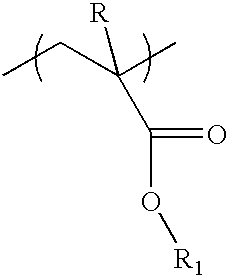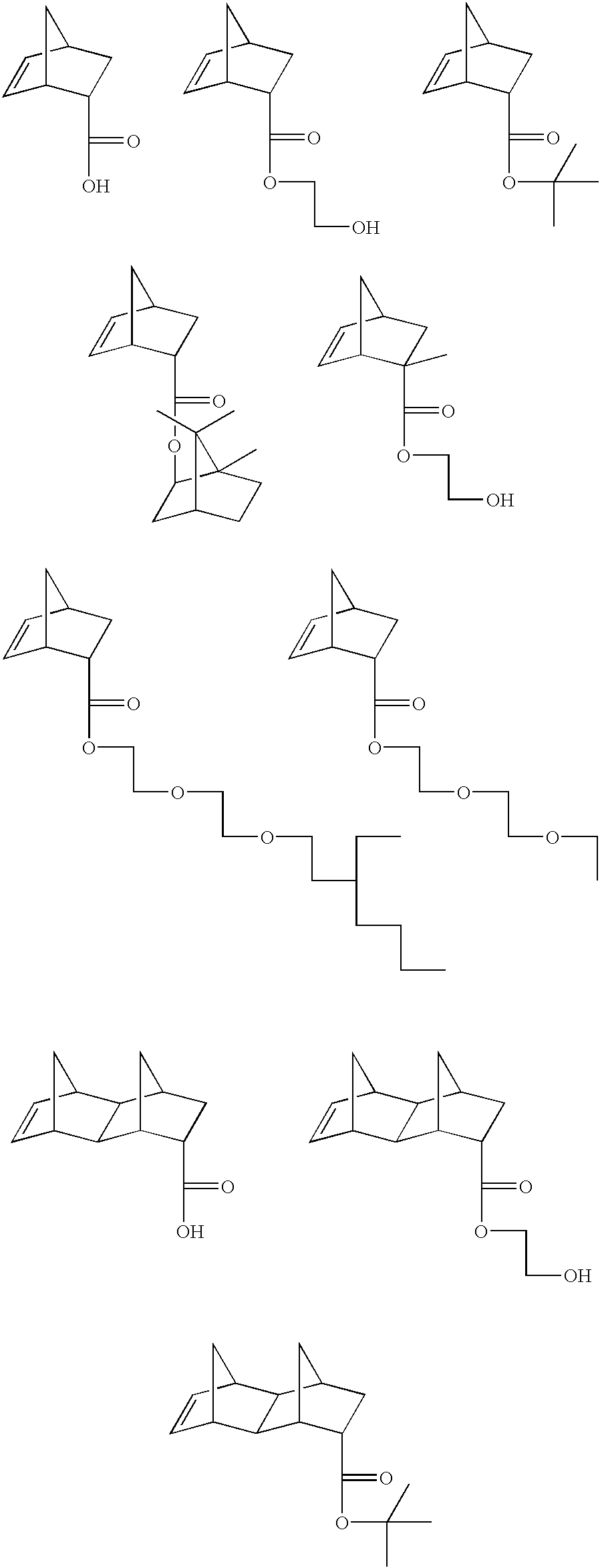Photoresist composition for deep UV and process thereof
a technology of resist composition and deep ultraviolet light, applied in the direction of photosensitive materials, instruments, photomechanical equipment, etc., can solve the problems of high etch rate, inability to use open-chain aliphatic resins at 193 nm, and resist materials applicable for 248 nm cannot be used at 248 nm
- Summary
- Abstract
- Description
- Claims
- Application Information
AI Technical Summary
Problems solved by technology
Method used
Image
Examples
example 1
A copolymer is synthesized from 28.2 g of t-butyl norbornene carboxylate (BNC), 4.82 g of hydroxyethyl norbornene carboxylate (HNC), 1.82 g of norbornene carboxylic acid(NC), 7.85 g of mevaloniclactone methacrylate (MLMA) and 9.27 g of 2-methyladamantyl methacrylate (MAdMA) and 26 g of maleic anhydride(MA) in presence of 2 weight % of AIBN in tetrahydrofuran(THF) at 60% solid. The reaction was carried out under pressure, where the starting pressure was about 48,260 Pascals (7 psi) for 18 hours and the polymer was isolated from diethyl ether twice(1 / 10 v / v ratio). Test results for the polymer are shown in Table 1.
example 2
The synthesis procedure of Example 1 was repeated using 15.89 g of BNC, 4.26 g of HNC, 1.61 g of NC, 11.60 g MLMA and 13.71 g of MAdMA, and 22.93 g of MA. The polymer was isolated as described in Example 1. Test results for the polymer are shown in Table 1.
example 3
A copolymer is synthesized from 15.89 g of t-butyl norbornene carboxylate (BNC), 4.26 g of hydroxyethyl norbornene carboxylate (HNC), 1.61 g of norbornene carboxylic acid(NC), 11.60 g of mevaloniclactone methacrylate (MLMA) and 13.71 g of 2-methyladamantyl methacrylate (MAdMA) and 22.93 g of maleic anhydride(MA) in presence of 2 weight % of AIBN in tetrahydrofuran(THF) at 60% solid. The reaction was carried out under pressure, where the starting pressure was about 48,260 Pascals (7 psi) for 18 hours and the polymer was isolated from diethyl ether twice(1110 v / v ratio). Test results for the polymer are shown in Table 1.
PUM
| Property | Measurement | Unit |
|---|---|---|
| wavelengths | aaaaa | aaaaa |
| of wavelength in the range | aaaaa | aaaaa |
| temperature | aaaaa | aaaaa |
Abstract
Description
Claims
Application Information
 Login to View More
Login to View More - R&D
- Intellectual Property
- Life Sciences
- Materials
- Tech Scout
- Unparalleled Data Quality
- Higher Quality Content
- 60% Fewer Hallucinations
Browse by: Latest US Patents, China's latest patents, Technical Efficacy Thesaurus, Application Domain, Technology Topic, Popular Technical Reports.
© 2025 PatSnap. All rights reserved.Legal|Privacy policy|Modern Slavery Act Transparency Statement|Sitemap|About US| Contact US: help@patsnap.com



